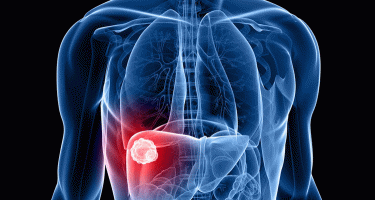
Primary liver cancer is on the rise worldwide, largely due to an increase in hepatitis C infections and chronic liver disease.
Liver cancer is also hard to treat - it kills 750,000 people a year worldwide, making it the second deadliest type of cancer behind lung cancer.
Current treatments include a targeted radiation therapy delivered with the help of radiation-emitting glass beads.
New research shows that this treatment can be augmented by infusing microbubbles - small gas bubbles surrounded by a lipid shell - into the liver, and popping those bubbles by ultrasound, in a first-in-human pilot clinical trial of the combination.
The findings of this study were published in Radiology.
"This approach has shown to be effective in preclinical studies using animal models of other solid tumours like bladder, prostate, and breast cancer," says John Eisenbrey, PhD, associate professor of radiology and lead author of the study. "This is the first work to demonstrate this approach is safe and shows promise in humans with liver cancer, which is very exciting."
About 15-25% of patients with advanced disease are recommended a treatment called trans-arterial radioembolisation, whereby radioactive glass beads are inserted into blood vessels the liver, and the radiation emitted provides a therapeutic dose to the tumour, destroying it.
However, the extent to which the radiation can penetrate liver tissue is limited, and tumour response is highly dependent on distance from the radioactive beads.
By combining microbubbles with TARE, the synergistic approach reduces the dose of radiation needed to kill blood vessels in the tumour and increases the effectiveness of treatment.
"The microbubbles themselves are found in commercially available ultrasound contrast agents," says Colette Shaw, MD, associate professor and interventional radiologist, and the lead clinical author of the study. "The procedure to get the microbubbles into the tumour involves similar techniques used to access blood vessels."
When the microbubbles are hit with the ultrasound wave, they start to vibrate and if the wave is strong enough, they burst.
The sheer energy of these tiny explosions causes physical and chemical damage to the blood vessels of the tumours, making them more sensitive to radiation.
By targeting the ultrasound to exactly where the tumours are, the researchers can burst or destroy the bubbles right where the radiation beads are and achieve highly localised sensitisation
The pilot study enrolled 28 patients who were randomly assigned to two treatment groups - trans-arterial radioembolisation alone (TARE) or radioembolisation and ultrasound-triggered destruction of microbubbles (TARE UTMD).
The team first evaluated the safety profile of the microbubbles - they observed no changes in vital signs like body temperature, blood pressure, and heart rate in patients receiving UTMD.
Importantly, UTMD did not compromise liver function, and there were no additional side effects of the combined approach.
The researchers looked at 10 tumours in the TARE only group, and 15 tumours in the TARE UTMD group, and evaluated tumour response to each treatment.
93% of tumours showed partial to complete response to the TARE UTMD approach, while only 50% showed a response in the TARE alone group.
The team also found that patients receiving the combined therapy were also more likely to receive a liver transplant, which offers the best chance for long term survival for patients with cirrhosis and liver cancer.
These patients also lived longer, and required fewer retreatments compared to those receiving TARE alone.
"Even at this early stage, we've been able to show a significant improvement in tumour outcomes with this combined therapy," says Dr. Shaw. "Looking ahead, we are enrolling more patients to demonstrate key benchmarks in the promise of this approach."
"Our findings are really setting the stage for a whole range of studies to be done in humans," says Dr. Eisenbrey. "This approach could be effective in treating metastatic liver tumours, but also other types of primary cancer. The bubbles themselves can also be engineered to deliver chemotherapy or oxygen as they burst. This is really the tip of the iceberg."
Source: Thomas Jefferson University
The World Cancer Declaration recognises that to make major reductions in premature deaths, innovative education and training opportunities for healthcare workers in all disciplines of cancer control need to improve significantly.
ecancer plays a critical part in improving access to education for medical professionals.
Every day we help doctors, nurses, patients and their advocates to further their knowledge and improve the quality of care. Please make a donation to support our ongoing work.
Thank you for your support.